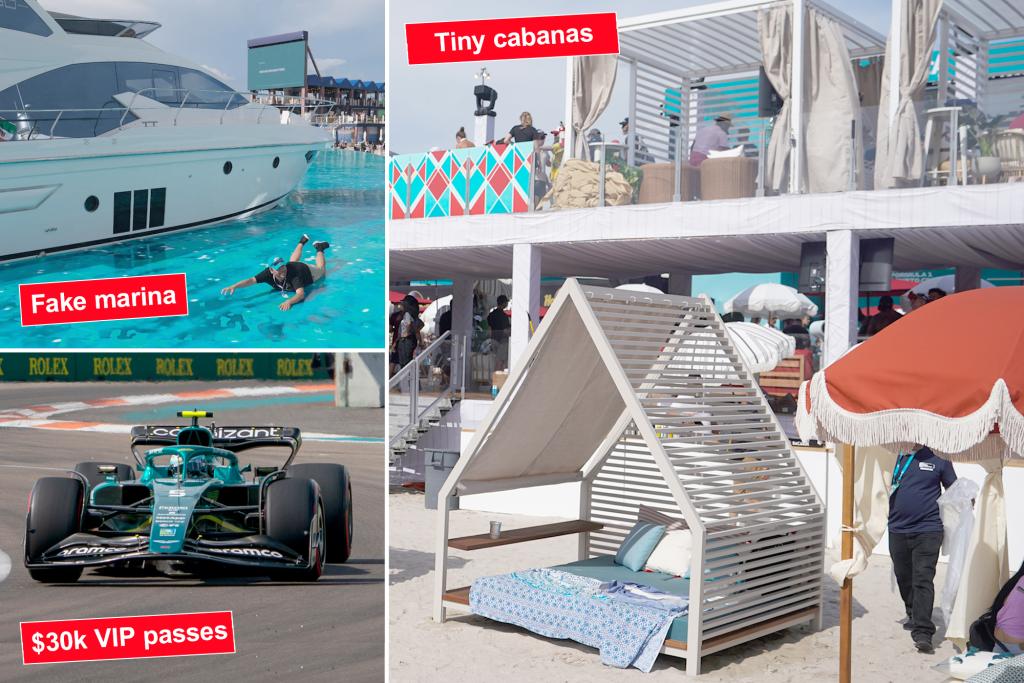Over the weekend, Miami hosted the inaugural Formula One Miami Grand Prix — a sport whose luxury branding has made it synonymous with glamor, superyachts and European royalty. The city spent much of the last year building its 5.41-km (about 3.4-mile) track and touting the over-the-top viewing experiences at every turn.
There was a beach club in the middle of the track with imported sand and swimming pools. Ten yachts were brought into the “marina,” a VIP area with DJs, top-shelf alcohol and pretty people. (So what if there was no real water? The boats were on dry ground and painted blue to make it look like the sea on TV.) Gondolas, branded by Heineken, hovered high above the track to give viewers a bird’s-eye view of the race. Casa Tua, one of Miami’s top restaurants, set up a nightclub at Turn 1. Hendrick’s Gin had a bar with actors spraying passersby with water guns. Celebrities including Tom Brady, Michael Jordan, and David Beckham were seen in the paddock on race day.
Yet, while Miami charged first-class prices to participate in the fun — even the cheapest grandstand seats cost almost a grand, while VIP tickets reached the $30,000 mark — some attendees said the event was anything but five-star.


“For what was touted as a world-class experience came away feeling like the Fyre Festival of F1 races,” said one 26-year-old who works in financial services and declined to provide his name for fear of backlash over his attending such a pricey event. He paid $815 for his ticket and drove almost 10 hours from Alpharetta, Georgia, where he lives, for the festivities.
In Monaco, drivers zip around century-old palaces and stunning beachfront property; in Miami, winner Max Verstappen sped around the Hard Rock Stadium. Meanwhile, F1 races from Singapore to Monaco usually have a waterfront component for yachts; here, the “water” was painted on.
“I’d say just the lack of the true marina circuit cheapened the whole experience,” he said. “It was thousands for a ticket to a track that was basically a parking lot.”



Trendy restaurant experiences were promised, so he was confused by some of the food choices. “Inside the first entry gate, they had a potato stand that was really weird. It didn’t have fries, but said potatoes,” he said. “It seemed odd for an F1 race.”
Marcy, a 39-year-old who works in communications in Los Angeles who didn’t want to give her last name because a colleague pulled in special favors to get her tickets (she still paid $2,500 for two), said she actually enjoyed the hospitality. “The opening ceremonies, the music lineup, the fans, all the top-notch food vendors at every corner, the talented drivers, and all the drama at each turn,” she said. “It was actually really fun once you got there.”
The problem is that it took her over an hour and a half to get to and from her seats. “The parking pass we purchased with our ticket didn’t match up with the gate we were closest to for entry,” she said. “The fun of the race was a little overshadowed by logistics.”


Other attendees, already encumbered by the 90-degree temperatures, complained that it was confusing to get around the autodrome. Walking somewhere that looked close by on the map required going up and down multiple footbridges in reality. Staff members were just as confused as guests about where to send people; many simply shrugged when asked where a particular area was.
Meanwhile on Reddit, a user posted about confusion over misplaced row stickers, which allegedly caused some “people who paid $1,500 for these seats … to sit on the stairs because the staff couldn’t figure it out either.”
Representatives for Formula One did not return requests for comment.
One 58-year-old woman who works in luxury travel and has attended Grands Prix all over the world traveled all the way from Monaco, where she lives, for the race.


She said the situation was dire even in one of the most exclusive areas known as the Paddock Club that is found at every Grand Prix. (It’s where JPMorgan hosted guests, for example.)
“There was also a lack of parking and carts to take the VIPs to their areas,” said the woman, who declined to give her name because of her close ties to the industry. She said the area was also set up so guests couldn’t even see the podium, a perk they paid for.
While in Monaco there would be raw bars, fresh fish and an array of decadent desserts, in Miami there was cold chicken and messy burgers. Instead of being served on beautifully set tables, guests helped themselves to a buffet and found a seat in an area that she said resembled a cafeteria.
After attending the qualifying round on Saturday, she declined to go back to the track on Sunday, opting instead to watch the race on a large screen by the pool at the Faena Hotel.
“F1 is supposed to be the most luxurious motorsport series, so the hospitality should reflect that,” she said. “Unfortunately, there was nothing luxurious about Miami.”
.
